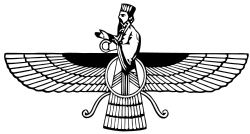Rashn Yasht
| Part of a series on |
| Zoroastrianism |
|---|
 |
|
|
The Rashn Yasht is the twelfth Yasht of the 21 Yasht collection. It is named after and dedicated to the veneration of Rashnu, the Zoroastrian divinity representing Justice.[1]
Structure
The Rashn Yasht consists of 39 stanzas, but it is sometimes additionally divided into 30 or 31 sections called Kardes. Such a subdivision can be found for many of the Yashts. Its application to the Rash Yasht, however, is inconsistent, since several of the oldest manuscript traditions do not have it.[2] As a consequence, there is no consensus in modern editions of the Yasht as well. While, e.g., Westergaard[3] and Darmesteter[4] divide the Yasht into Kardes in their editions, Geldner[5] and Lommel[6] do not.
Content
The Rashn Yasht begins with the typical framing of many Yashts, as a dialogue between Zarathustra and Ahura Mazda. Unlike other Yashts, however, this framing device is not used during the rest of the text.[7] The next part is formed by stanzas 3-8. These verses include a description of the ritual actions that are needed to start the ordeal.[8] The last part is by far the largest one and is formed by stanzas 9-37. It consists of a long list of 29 place names from which Rashnu is called forth to attend the ordeal.[9] These verses are important for understanding the world view of the early Iranians.[10]
Use
It has been assumed that the main part of the Yasht (stanzas 3-37) was originally used during Avestan times at a trial by ordeal.[11] The opening stanzes may, therefore, have been added later to align the text with the structure established by other Yashts.[12] During Sasanian period it was part of the Bagan yasht where it may have formed the 9th chapter.[13] In modern Zoroastrian practice, the Rashn Yasht is recited on the days the 7th, 18th, 26th, and 28th of the month in the Zoroastrian calendar, dedicated to Ameretat, Rashnu, Arshtat, and Zam, respectively.[14]
Editions and translations
The Rashn Yasht is extant in thirteen manuscripts in total, none of which contain a translation into Middle Persian.[15] They have been made available in a number of editions and translations, typically as part of the Yasht collection of the Khordeh Avesta. Darmesteter published in 1883 a translation into English[4] and in 1892 a translation into French.[16] In 1927, Lommel published a translation of the Yasht collection into German.[17] In 2009, Éric Pirart published an edition dedicated to the Rashn Yasht specifically and accompanied by a translation into French.[18] In 2015, Leon Goldman published a critical edition of the Rashn Yasht accompanied by an English translation, commentary and glossary.[19]
References
Citations
- ^ Goldman 2012.
- ^ Goldman 2015, p. 5.
- ^ Westergaard 1854, pp. 217-221.
- ^ a b Darmesteter 1883, pp. 168-178.
- ^ Geldner 1896, pp. 163-167.
- ^ Lommel 1927, p. 95: "Dieser Yäsht entbehrt wie mehrere der kleinerer Yäshts der charakteristischen Einteilung in die von stehenden Formeln umrahmten Kärda".
- ^ Lommel 1927, p. 95: "[D]ie anfangs gewählte Form der Zwiesprache mit Verkündigung durch Ahura Mazda [ist] nicht durchgeführt".
- ^ Goldman 2012, "The following six stanzas (vv. 3-8) contain a set of technical instructions dictated by Ahura Mazdā and relate to the varah".
- ^ Goldman 2012, "each verse begins with the line "Be you, O truthful Rašnu at ...", followed by the name of a place, and concludes with a repetition of vv. 5-8, which invite Rašnu to be present".
- ^ Yarshater 1983, p. 352.
- ^ Goldman 2015, p. 4: "In order to lend this a suitably Yašt-like feel, it was prefixed with a frašna fragment whose lines contain echoes of other Yašts (Yts.1, 8 and 19 22 ).l".
- ^ König 2017, p. 21.
- ^ Darmesteter 1883, p. 168: "This Yast is recited on the days of Rashn, Murdad, Ashtad, and Zemyad (the 18th, 7th, 26th, and 28th of the month)".
- ^ Goldman 2012, "It is attested in thirteen manuscripts (F1 E1 Pt1 P13 O3 L18 K12 J18 J10 J19 W2 Ml2 B27) of both the Khorde Avesta and pure Yašt types. It exists only in Avestan and comprises 39 verses".
- ^ Darmesteter 1892, pp. 490-499.
- ^ Lommel 1927, pp. 95-101.
- ^ Pirart 2009.
- ^ Goldman 2015.
Bibliography
- Darmesteter, James (1883). Müller, Max (ed.). Zend-Avesta II: The Sirozahs, Yasts and Nyayis. Sacred Books of the East. Vol. 23. Dehli: Motilal Banarsidass Publishers.
- Darmesteter, James (1892). Le Zend-Avesta, Vol. 2: Traduction Nouvelle Avec Commentaire Historique Et Philologique; La Loi (Vendidad); L'Épopée (Yashts); Le Livre de Prière (Khorda Avesta). Paris: E. Leroux.
- Geldner, Karl F. (1896). Avesta The Sacred Books Of The Parsis. Vol. 2. Stuttgart: Kohlhammer.
- Goldman, Leon (2012). "RAŠN YAŠT". Encyclopædia Iranica. New York: Routledge and Kegan Paul.
- Goldman, Leon (2015). Rasn Yast - The Avestan Hymn to 'Justice'. Beiträge zur Iranistik. Vol. 39. Wiesbaden: Reichert Verlag. doi:10.29091/9783954906109. ISBN 9783954906109.
- König, Götz (2017). "Bayān Yasn: State of the Art". Iran and the Caucasus 2. 21: 13–38. doi:10.1163/1573384x-90000003.
- Lommel, Herman (1927). Die Yäšt's des Awesta. Quellen der Religionsgeschichte: Iran. Vol. 15. Vandenhoeck & Ruprecht.
- Pirart, Éric (2009). "Le Rašn Yašt (Yt 12)". Zarathushtra entre l'Inde et l'Iran. Études indo-iraniennes et indo-européennes offertes à Jean Kellens à l'occasion de son 65e anniversaire. Wiesbaden: Dr Ludwig Reichert. pp. 221–249. ISBN 978-3895006517.
- Westergaard, Niels L. (1854). Zendavesta: or The religious books of the Zoroastrians. Berling brothers.
- Yarshater, Ehsan (1983). "Iranian Common Beliefs and World-View". In Yarshater, Ehsan (ed.). The Cambridge History of Iran. Vol. 3(1). Cambridge University Press. ISBN 978-0-521-24693-4.
External links
- Avestan text of the Rashn Yasht at Avesta.org
- English translation of the Rashn Yasht by James Darmesteter at Avesta.org
